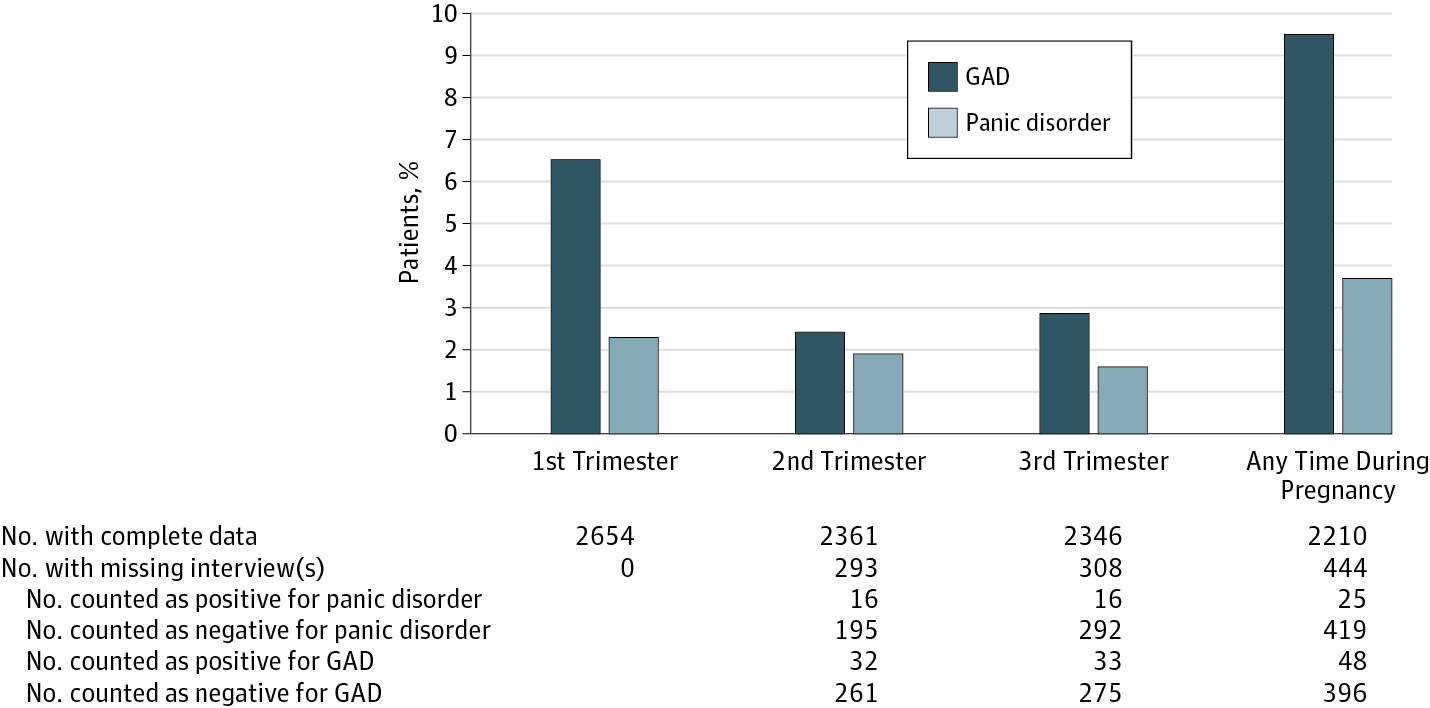JAMA Psychiatry ( IF 22.5 ) Pub Date : 2017-11-01 , DOI: 10.1001/jamapsychiatry.2017.2733 Kimberly Ann Yonkers 1 , Kathryn Gilstad-Hayden 2 , Ariadna Forray 2 , Heather S. Lipkind 3

|
Importance Registry data show that maternal panic disorder, or anxiety disorders in general, increase the risk for adverse pregnancy outcomes. However, diagnoses from registries may be imprecise and may not consider potential confounding factors, such as treatment with medication and maternal substance use.
Objective To determine whether panic disorder or generalized anxiety disorder (GAD) in pregnancy, or medications used to treat these conditions, are associated with adverse maternal or neonatal pregnancy outcomes.
Design, Setting, and Participants This cohort study conducted between July 1, 2005, and July 14, 2009, recruited women at 137 obstetric practices in Connecticut and Massachusetts before 17 weeks of pregnancy and reassessed them at 28 (±4) weeks of pregnancy and 8 (±4) weeks postpartum. Psychiatric diagnoses were determined by answers to the World Mental Health Composite International Diagnostic Interview. Assessments also gathered information on treatment with medications and confounding factors, such as substance use, previous adverse birth outcomes, and demographic factors.
Exposure Panic disorder, GAD, or use of benzodiazepines or serotonin reuptake inhibitors.
Main Outcomes and Measures Among mothers: preterm birth, cesarean delivery, and hypertensive diseases of pregnancy. Among neonates: low birth weight, use of minor respiratory interventions, and use of ventilatory support.
Results Of the 2654 women in the final analysis (mean [SD] age, 31.0 [5.7] years), most were non-Hispanic white (1957 [73.7%]), 98 had panic disorder, 252 had GAD, 67 were treated with a benzodiazepine, and 293 were treated with a serotonin reuptake inhibitor during pregnancy. In adjusted models, neither panic disorder nor GAD was associated with maternal or neonatal complications of interest. Most medication exposures occurred early in pregnancy. Maternal benzodiazepine use was associated with cesarean delivery (odds ratio [OR], 2.45; 95% CI, 1.36-4.40), low birth weight (OR, 3.41; 95% CI, 1.61-7.26), and use of ventilatory support for the newborn (OR, 2.85; 95% CI, 1.2-6.9). Maternal serotonin reuptake inhibitor use was associated with hypertensive diseases of pregnancy (OR, 2.82; 95% CI, 1.58-5.04), preterm birth (OR, 1.56; 95% CI, 1.02-2.38), and use of minor respiratory interventions (OR, 1.81; 95% CI, 1.39-2.37). With maternal benzodiazepine treatment, rates of ventilatory support increased by 61 of 1000 neonates and duration of gestation was shortened by 3.6 days; with maternal serotonin reuptake inhibitor use, gestation was shortened by 1.8 days, 152 of 1000 additional newborns required minor respiratory interventions, and 53 of 1000 additional women experienced hypertensive diseases of pregnancy.
Conclusions and Relevance Panic disorder and GAD do not contribute to adverse pregnancy complications. Women may require treatment with medications during pregnancy, which can shorten the duration of gestation slightly. Maternal treatment with a serotonin reuptake inhibitor is also associated with hypertensive disease of pregnancy and cesarean delivery.
中文翻译:

妊娠期间恐慌症,广泛性焦虑症和苯二氮卓类药物治疗与不良出生风险的关系
重要的 注册表数据显示,孕妇惊慌症或一般的焦虑症会增加不良妊娠结局的风险。但是,来自注册表的诊断可能不准确,可能未考虑潜在的混淆因素,例如药物治疗和母体药物使用。
目的 确定妊娠中的恐慌症或广泛性焦虑症(GAD)或用于治疗这些状况的药物是否与不良的孕妇或新生儿妊娠结局相关。
设计,背景和参与者 这项队列研究于2005年7月1日至2009年7月14日进行,在怀孕17周之前在康涅狄格州和马萨诸塞州的137个产科诊所招募了女性,并在怀孕28(±4)周时对她们进行了重新评估。产后8(±4)周。精神科的诊断是根据《世界精神卫生综合国际诊断访谈》的答案确定的。评估还收集了有关药物治疗和混杂因素的信息,例如药物使用,先前的不良出生结局和人口统计学因素。
暴露 恐慌症,GAD或使用苯二氮卓类或5-羟色胺再摄取抑制剂。
母亲的主要结果和措施:早产,剖宫产和妊娠高血压疾病。在新生儿中:低出生体重,使用较小的呼吸干预和使用通气支持。
结果 最终分析的2654名妇女(平均[SD]年龄,31.0 [5.7]岁)中,大多数为非西班牙裔白人(1957 [73.7%]),其中98名患有惊慌症,252名患有GAD,67名接受了阿霉素治疗。妊娠期间,苯二氮卓和293用5-羟色胺再摄取抑制剂治疗。在调整后的模型中,恐慌症和GAD均与孕妇或新生儿所关注的并发症无关。大多数药物暴露发生在怀孕初期。孕妇使用苯二氮卓类药物与剖宫产(赔率[OR]为2.45; 95%CI为1.36-4.40),低出生体重(OR为3.41; 95%CI为1.61-7.26)和通气支持有关。新生儿(OR,2.85; 95%CI,1.2-6.9)。孕妇使用血清素再摄取抑制剂与妊娠高血压疾病(OR,2.82; 95%CI,1.58-5.04),早产(OR,1.56; 95%CI,1.02-2.38)相关,以及使用较小的呼吸道干预措施(OR,1.81; 95%CI,1.39-2.37)。孕产妇苯二氮卓治疗使通气支持率增加了1000例新生儿中的61例,妊娠时间缩短了3.6天。与母体使用5-羟色胺再摄取抑制剂后,妊娠缩短了1.8天,另外1000名新生儿中的152名需要进行轻微的呼吸干预,另外1000名女性中的53名患有妊娠高血压疾病。
结论与相关性 恐慌症和GAD不会导致不良妊娠并发症。妇女在怀孕期间可能需要用药物治疗,这可能会稍微缩短妊娠时间。用5-羟色胺再摄取抑制剂进行孕产妇治疗也与妊娠高血压疾病和剖宫产有关。











































 京公网安备 11010802027423号
京公网安备 11010802027423号